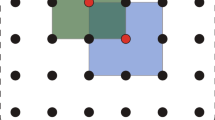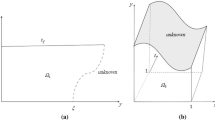Summary
A new meshless method is developed to analyze steady-state heat conduction problems with arbitrarily spatially varying thermal conductivity in isotropic and anisotropic materials. The analog equation is used to construct equivalent equations to the original differential equation so that a simpler fundamental solution of the Laplacian operator can be employed to take the place of the fundamental solutions related to the original governing equation. Next, the particular solution is approximated by using radial basis functions, and the corresponding homogeneous solution is solved by means of the virtual boundary collocation method. As a result, a new method fully independent of mesh is developed. Finally, several numerical examples are implemented to demonstrate the efficiency and accuracy of the proposed method. The numerical results show good agreement with the actual results.
Similar content being viewed by others
References
Nowak, A.J.; Brebbia, C.A.: The multiple-reciprocity method. A new approach for transforming BEM domain integrals to the boundary. Eng Anal Bound Elem 6(3) 164–167 (1989)
Nowak, A.J.; Brebbia, C.A.: Numerical verification of the multiple reciprocity method for linear potential problems with body forces. Eng Anal Bound Elem 10 259–266 (1992)
Nardini, D.; Brebbia, C.A.: A new approach to free vibration analysis using boundary elements. In: Brebbia, C.A.: (ed) Boundary element methods in engineering proceedings. 4th International Seminar, Southampton. Springer, Berlin Heidelberg New York 1982 312–326
Nowak, A.J.; Partridge, P.W.: Comparison of the dual reciprocity and the multiple reciprocity methods. Eng Anal Bound Elem 10 155–160 (1992)
Katsikadelis, J.T.: The analog equation method– a powerful BEM– based solution technique for solving linear and nonlinear engineering problems. In: Brebbia, C.A.: (ed) Boundary element method XVI. CLM Publications, Southampton (1994) pp. 167
Sun, H.C.; Zhang, L.Z.: Nonsingularity boundary element methods (in Chinese). Dalian University of Technology Press, Dalian (1999)
Sun, H.C.; Yao, W.A.: Virtual boundary element-linear complementary equations for solving the elastic obstacle problems of thin plate. Finite Elem Anal Des 27 153–161 (1997)
Golberg, M.A.; Chen, C.S.: The method of fundamental solutions for potential, Helmholtz and diffusion problems. In: Golberg, M.A.: (ed) Boundary integral methods – numerical and mathematical aspects. Computational Mechanics Publications. pp. 103–176 (1998)
Chen, W.; Tanaka, M.; Meshless, A.: Integration-free and boundary-only RBF technique. Comput Math Appl 43 379–391 (2002)
Chen, W.; Hon, Y.C.: Numerical investigation on convergence of boundary knot method in the analysis of homogeneous Helmholtz, modified Helmholtz, and convection–diffusion problems. Comput Methods Appl Mech Eng 192 1859–1875 (2003)
Chen, W.: Meshfree boundary particle method applied to Helmholtz problems. Eng Anal Bound Elem 26 577–581 (2002)
Chen, W.: High-order fundamental and general solutions of convection–diffusion equation and their applications with boundary particle method. Eng Anal Bound Elem 26 571–575 (2002)
Chang, Y.P.; Kang, C.S.; Chen, D.J.: The use of fundamental Green’s functions for the solution of heat conduction in anisotropic media. Int J Heat Mass Transfer 16 1905–1918 (1973)
Partridge, P.W.: Approximation functions in the dual reciprocity method. Int J Bound Elem Commun 8 1–4 (1997)
Zhang, Y.; Zhu, S.: On the choice of interpolation functions used in the dual-reciprocity boundary-element method. Eng Anal Bound Elem 13 387–396 (1994)
Golberg, M.A.; Chen, C.S.; Bowman, H.: Some recent results and proposals for the use of radial basis functions in the BEM. Eng Anal Bound Elem 23 285–296 (1999)
Yamada, P.W.; Wrobel, L.C.; Power, H.: On the convergence of the dual reciprocity method. Eng Anal Bound Elem 13 291–298 (1994)
Mitic, P.; Rashed, Y.F.: Convergence and stability of the method of meshless fundamental solutions using an array of randomly distributed sources. Eng Analy Bound Elem 28 143–153 (2004)
Kassab, A.J.; Divo, E.: A generalized boundary integral equation for isotropic heat conduction with spatially varying thermal conductivity. Eng Analy Bound Elem 18 273–286 (1996)
Divo, E.; Kassab, A.J.: Generalized boundary integral equation for heat conduction in non-homogeneous media: recent developments on the sifting property. Eng Anal Bound Elem 22 221–234 (1998)
Mera, N.S.; Elliott, L.; Ingham, D.B.; Lesnic, D.: A comparison of boundary element method formulations for steady state anisotropic heat conduction problems. Eng Analy Bound Elem 25 115–128 (2001)
Author information
Authors and Affiliations
Corresponding author
Additional information
This work was supported by the National Natural Science Foundation of China (No. 10472082) and Australian Research Council.
Rights and permissions
About this article
Cite this article
Wang, H., Qin, QH. & Kang, Y. A new meshless method for steady-state heat conduction problems in anisotropic and inhomogeneous media. Archive of Applied Mechanics 74, 563–579 (2005). https://doi.org/10.1007/s00419-005-0375-8
Received:
Accepted:
Issue Date:
DOI: https://doi.org/10.1007/s00419-005-0375-8




